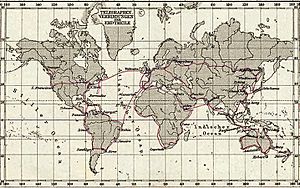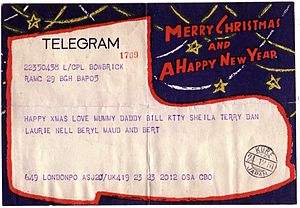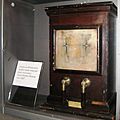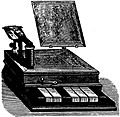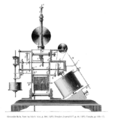Telegram facts for kids
A telegram was a special written message sent using electricity. Think of it like an early text message! The word "telegram" comes from Greek words meaning "distant" (tele) and "letter" (gramma). These messages traveled along wires, and then the text was written or printed out. Finally, someone would deliver the message by hand or using a machine called a teleprinter.
Telegrams were very popular for a long time. This was because most people did not have their own telephones at home. If you needed to send an urgent message quickly, a telegram was often the best way. Today, most people have telephones and use e-mail, so telegrams are not used much anymore. The idea for this fast message service was first developed by the British Post Office for urgent letters.
Contents
How Telegrams Worked
A telegram worked by sending electrical signals through wires. These signals represented letters and numbers. At the receiving end, a special machine would turn these signals back into a written message. This allowed people to send messages across long distances much faster than regular mail.
Sending a Telegram
To send a telegram, you would go to a telegraph office. You would write your message down, and an operator would use a special device, like a Morse key, to send it. The operator would tap out the message in Morse code, which is a series of short and long signals (dots and dashes).
Receiving a Telegram
At another telegraph office, an operator would receive the Morse code signals. They would then write down the message or use a teleprinter to print it. After that, a messenger would deliver the printed telegram directly to the person it was for. This made telegrams perfect for urgent news, like emergencies or important announcements.
Why Telegrams Were Important
Telegrams changed how people communicated. Before them, sending a message across a country could take days or even weeks by mail. Telegrams made it possible to send news in just hours. This was very important for businesses, governments, and families who needed to share information quickly. They helped connect the world long before the internet or mobile phones existed.
Telegrams Today
Today, telegrams are mostly a thing of the past. Modern technology like mobile phones, text messages, and email has replaced them. These new ways of communicating are much faster, cheaper, and easier to use. However, the idea of sending messages instantly over long distances, which started with the telegram, led to all the communication tools we use today.
Related pages
Images for kids
-
Replica of Claude Chappe's optical telegraph on the Litermont near Nalbach, Germany
-
Schematic of a Prussian optical telegraph (or semaphore) tower, c. 1835
-
Cooke and Wheatstone's five-needle, six-wire telegraph (1837)
-
An early Cooke and Wheatstone double-needle railway telegraph instrument at the National Railway Museum
-
Australian troops using a Mance mk.V heliograph in the Western Desert in November 1940
-
US Forest Service lookout using a Colomb shutter type heliograph in 1912 at the end of a telephone line
-
Creed paper tape reader at The National Museum of Computing
-
Marconi watching associates raising the kite (a "Levitor" by B.F.S. Baden-Powell) used to lift the antenna at St. John's, Newfoundland, December 1901
-
Post Office Engineers inspect Marconi's equipment on Flat Holm, May 1897
See also
 In Spanish: Telegrama para niños
In Spanish: Telegrama para niños


